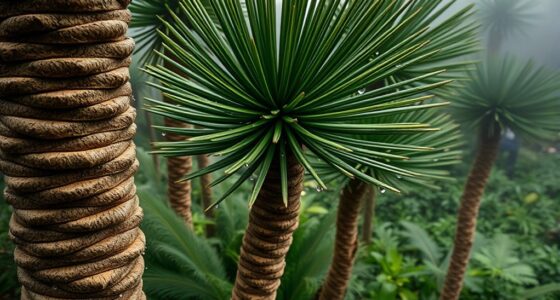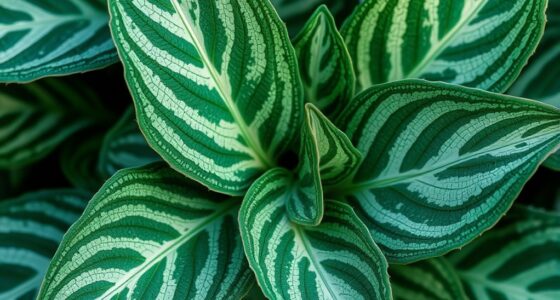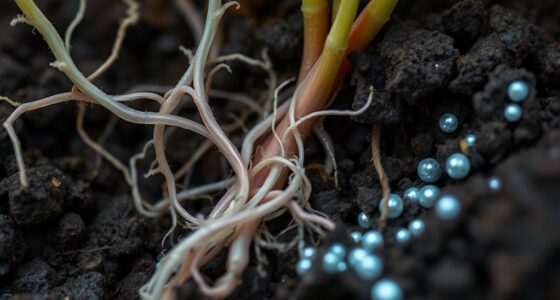Puya raimondii blooms only once in its lifetime because it dedicates decades of slow growth in the mountains before producing a spectacular, single flowering event. This massive display attracts pollinators and guarantees seed dispersal, maximizing its chances of survival in harsh environments. After flowering, the plant focuses energy on seed production and eventually dies, making room for new generations. If you want to discover what makes this event so unique, keep exploring.
Key Takeaways
- Puya Raimondii invests decades in growth, then channels all stored energy into a single, massive flowering event.
- The plant’s single bloom attracts pollinators, maximizing reproductive success during its brief flowering period.
- After flowering, energy resources are depleted, leading to leaf withering and eventual plant death.
- This one-time flowering ensures seed dispersal in rugged, high-altitude environments, promoting species survival.
- The lifecycle balances growth, reproduction, and death, an evolutionary adaptation to challenging ecological conditions.

Puya raimondii, often called the “Queen of the Andes,” is renowned for its extraordinary size and rarity, but few know about its spectacular, one-time flowering event that resembles a fireworks display. When you see this event, it’s impossible not to be struck by the plant’s grandeur. You might have heard about its impressive stature—some plants grow over 10 meters tall with a trunk that’s several meters wide—but the flowering process is equally astonishing. The plant invests decades growing silently in the mountains of Peru and Bolivia, quietly gathering energy for its moment of spectacle. Then, suddenly, it releases a burst of color and activity that lasts just a few weeks.
During this flowering, you’ll notice a towering flower spike that shoots upward with thousands of small, vibrant yellow flowers. It’s like a giant fireworks burst in slow motion. The spike is covered in dense clusters of blossoms, which attract various pollinators such as hummingbirds, bats, and insects. This spectacle isn’t just for show; it’s a carefully timed event driven by the plant’s life cycle. The plant channels all its stored energy into this single, massive bloom, a process that can take decades of growth to prepare for. You might think it’s a celebration of life, but it’s also a calculated gamble—after flowering, the plant begins to die.
Once the flowering is complete, the plant’s energy is depleted. You’ll notice the leaves start to wither, and the once-majestic stalk begins to decline. It’s a sad sight, but it’s also the natural order of this extraordinary plant. Its death after blooming is a survival strategy: by putting all its resources into one grand event, it guarantees the next generation can propagate through seed dispersal. The seeds are spread far and wide by the wind, carried on the mountain breezes beyond the parent plant’s reach. This method helps preserve the species in the rugged, often hostile environment of the high Andes. Additionally, the plant’s unique lifecycle exemplifies how plants adapt to challenging environments through specialized reproductive strategies involving synchronized flowering.
Your fascination with Puya raimondii’s lifecycle is rooted in understanding its delicate balance of growth, reproduction, and death. Its one-time flowering event is not just a biological marvel but a testament to nature’s ingenuity. You realize that each plant’s fleeting moment of glory is a culmination of decades of silent effort. And so, you watch in awe as it completes its cycle, knowing that this spectacular fireworks display is both a celebration of life and a poignant reminder of nature’s ephemeral beauty.
Frequently Asked Questions
How Long Does Puya Raimondii Take to Reach Flowering Age?
You’ll find that Puya Raimondii takes about 50 to 80 years to reach flowering age. During this time, it grows slowly and develops a sturdy rosette of leaves. Once it’s mature, it sends up a towering flower spike that can reach up to 10 meters tall. After blooming, it produces seeds and then dies, having completed its life cycle in a single, dramatic flowering event.
Can Puya Raimondii Survive in Non-Native Environments?
You probably won’t find Puya Raimondii thriving in non-native environments. It’s highly specialized to high-altitude regions of the Andes, requiring specific climate conditions like cool temperatures, well-drained soil, and ample sunlight. When you try to grow it outside its natural habitat, it struggles to adapt, often failing to survive. To keep it healthy, you need to mimic its native environment as closely as possible, which is quite challenging outside its usual range.
What Environmental Factors Trigger Its Flowering Process?
You see, the moment conditions become just right—like a lightning strike in a desert—you’ll witness Puya Raimondii explode into bloom. Its flowering is triggered by a combination of extreme altitude, intense sunlight, and seasonal rainfall, creating a perfect storm. The plant waits patiently, then bursts into a spectacular, one-time flower that stands taller than a skyscraper, signaling it’s time to complete its life cycle in a breathtaking, dramatic display.
Are There Conservation Efforts to Protect Puya Raimondii?
Yes, conservation efforts to safeguard Puya Raimondii are in place. You can support organizations working to preserve its natural habitat, like local NGOs and international conservation groups. They focus on habitat protection, raising awareness, and promoting sustainable land use. By participating in or funding these initiatives, you help guarantee the species’ survival, especially since its unique blooming cycle makes it vulnerable to environmental changes and human impacts.
How Does the Plant’s Unique Lifecycle Benefit Its Ecosystem?
You benefit from Puya raimondii’s unique lifecycle because its massive, once-in-a-lifetime flowering provides a crucial food source for pollinators like hummingbirds and insects. After it blooms and dies, the plant enriches the soil with organic matter, supporting other native plants. Its seed dispersal promotes genetic diversity and ecosystem resilience. This cycle sustains the local habitat, maintaining biodiversity and ecological balance in its high-altitude environment.
Conclusion
You stand before Puya Raimondii, a silent witness to its fleeting brilliance. Like a firework that lights up the night sky only once, it reminds you that some moments of beauty are transient, urging you to cherish their fleeting existence. Its final bloom symbolizes life’s ephemeral nature—bold, fleeting, yet unforgettable. As it dies, you realize that true majesty often comes in brief, brilliant flashes, leaving behind a lasting impression that whispers, “Enjoy the moment before it’s gone.”










